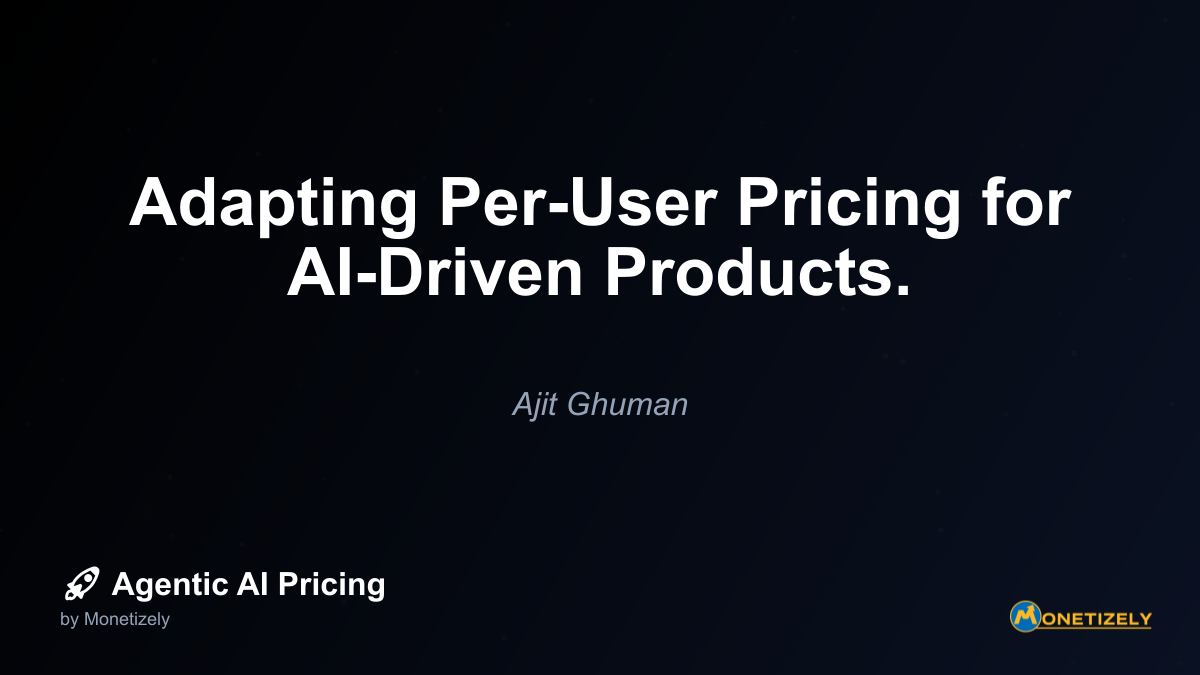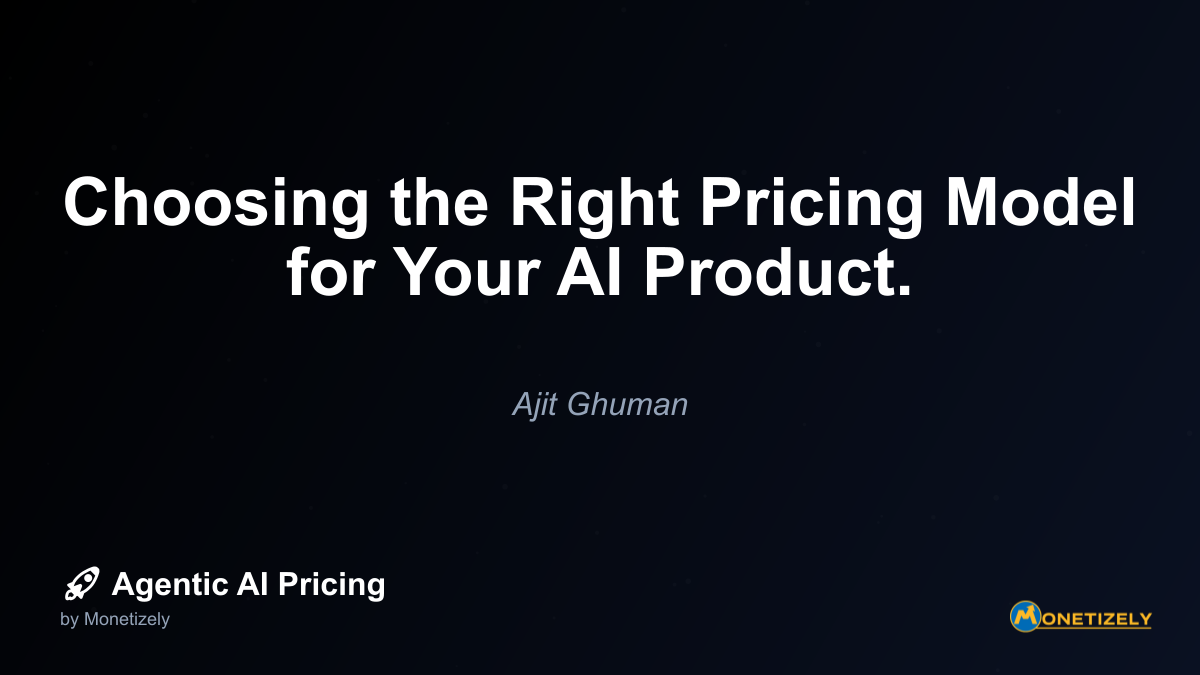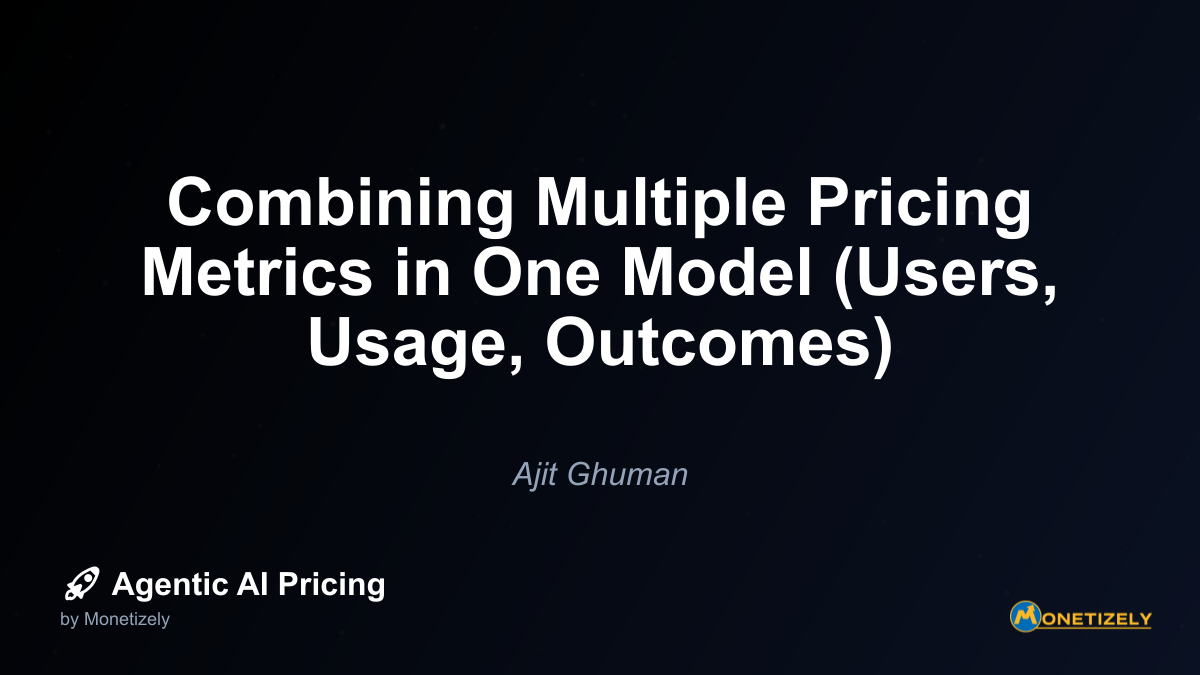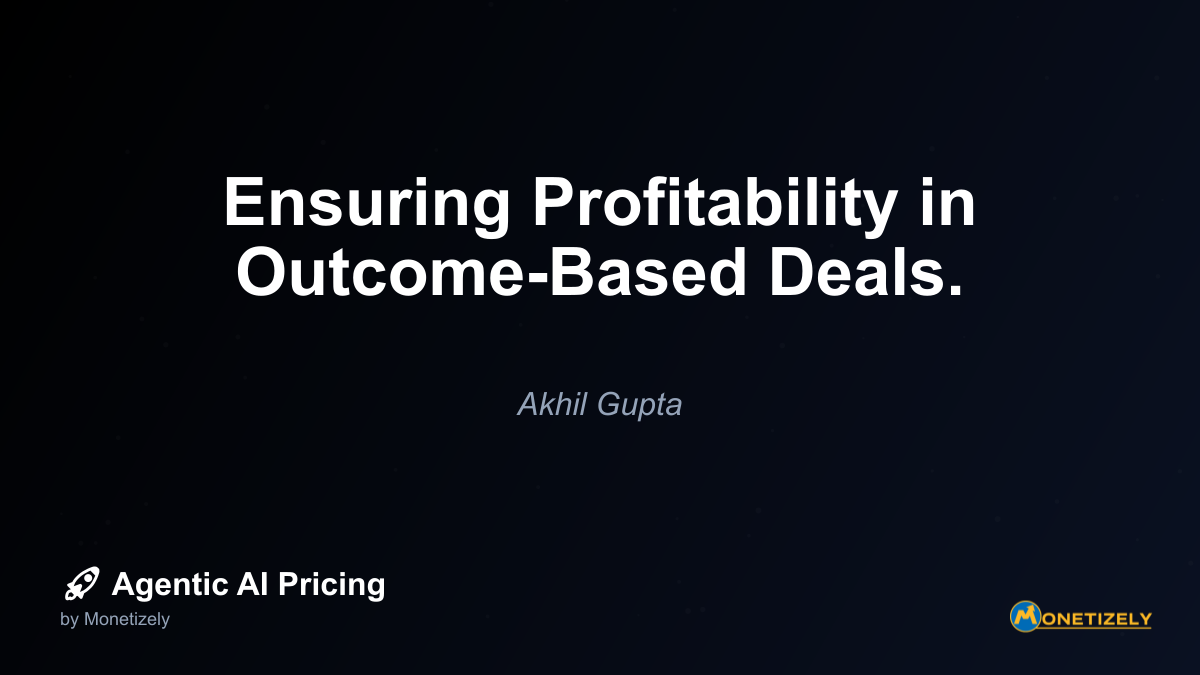· Akhil Gupta · Agentic AI Pricing Strategies · 8 min read
Subscription + Overage Model: Balancing Predictability and Flexibility.
AI and SaaS Pricing Masterclass
Learn the art of strategic pricing directly from industry experts. Our comprehensive course provides frameworks and methodologies for optimizing your pricing strategy in the evolving AI landscape. Earn a professional certification that can be imported directly to your LinkedIn profile.
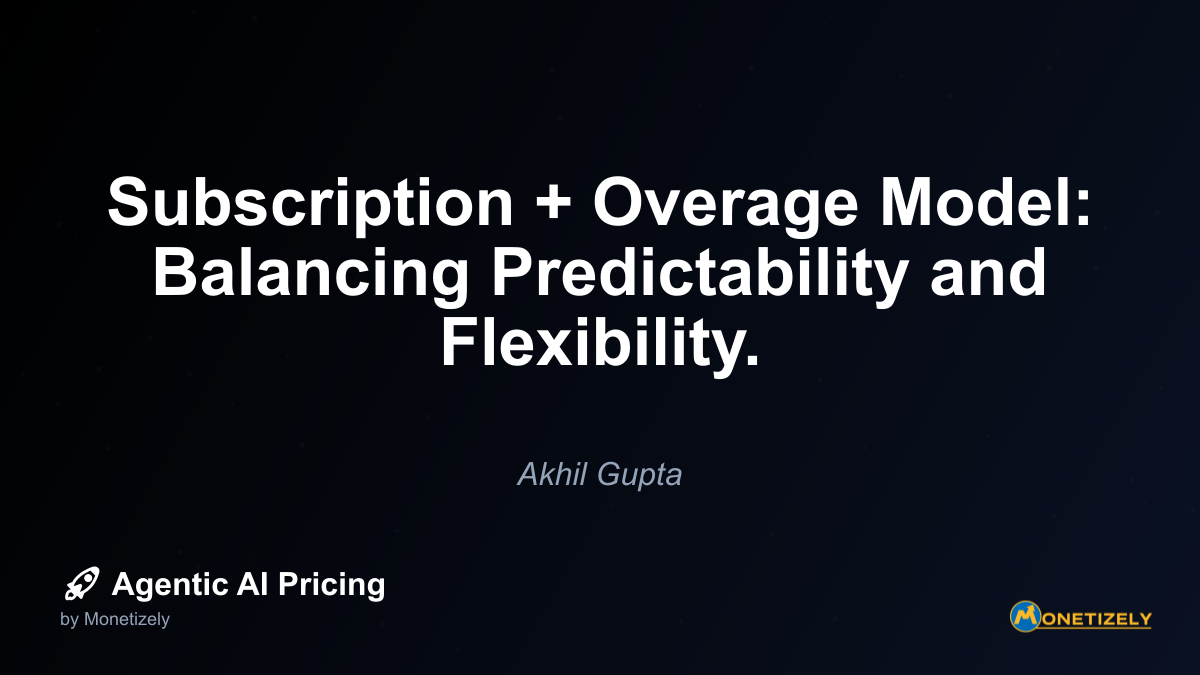
Subscription pricing with usage-based overage charges has emerged as a powerful hybrid model in the agentic AI landscape. This approach combines the predictability of subscription revenue with the flexibility of consumption-based billing, creating a balanced solution for both providers and customers. As organizations deploy increasingly sophisticated AI agents, finding the right pricing equilibrium has become critical for sustainable growth and customer satisfaction.
Understanding the Subscription + Overage Model
The subscription + overage model operates on a straightforward premise: customers pay a fixed recurring fee that includes a predetermined quota of AI usage or resources. When consumption exceeds this allocation, additional charges—overages—are applied based on actual usage. This model creates a predictable baseline revenue while allowing for upside potential when customers derive additional value from the system.
For agentic AI providers, this hybrid approach addresses several fundamental challenges in the market. First, it provides financial stability through guaranteed recurring revenue. Second, it creates natural alignment between costs and revenue, as heavy users contribute proportionally more. Finally, it offers customers a clear entry point with the flexibility to scale as their needs evolve.
Key Components of Effective Subscription + Overage Pricing
The Base Subscription Fee
The foundation of this model is the base subscription fee, which typically provides access to the core platform functionality and a set allocation of resources. When designing this component, providers must consider:
Value-Based Pricing: The base fee should reflect the minimum value customers receive regardless of usage volume. This includes access to the platform, basic support, and the included usage quota.
Segmentation Opportunities: Different subscription tiers can target various customer segments with appropriate resource allocations. Enterprise customers might receive higher quotas than small business users, reflecting their anticipated usage patterns.
Psychological Anchoring: The subscription creates a reference point for customers, establishing perceived value and setting expectations about the service’s worth beyond pure consumption metrics.
Quota Determination
Setting appropriate usage quotas requires careful analysis of customer behavior patterns and value perception:
Usage Analysis: Examine historical data to understand typical consumption patterns across different customer segments. The ideal quota should cover the needs of average users while leaving room for overages from power users.
Value Metrics Selection: Choose metrics that align with customer value perception. For conversational AI agents, this might be the number of conversations, tokens processed, or unique user interactions.
Competitive Positioning: Evaluate how your quota compares to alternatives in the market, including both direct competitors and potential substitutes.
Overage Structure Design
The overage component requires particular attention, as it directly impacts customer experience during periods of high usage:
Pricing Tiers vs. Linear Scaling: Providers can implement either tiered pricing (e.g., first 1,000 additional interactions at one price, next 5,000 at another) or linear per-unit pricing for overages. Tiered approaches often feel more predictable to customers.
Declining Block Rates: Many successful implementations use declining rates for higher usage volumes, acknowledging the economies of scale and encouraging increased adoption.
Caps and Safety Mechanisms: Consider implementing usage caps or notification systems to prevent “bill shock” when customers unexpectedly exceed their quotas.
Balancing Predictability and Flexibility
The primary advantage of this model is its ability to balance competing needs for both providers and customers:
Provider Benefits
Revenue Predictability: The subscription component creates a reliable revenue baseline, simplifying financial planning and investor relations.
Cost Recovery: Usage-based overages ensure that customers who consume more resources contribute proportionally to the costs they generate.
Expansion Opportunity: The model naturally accommodates customer growth, as increased usage automatically translates to higher revenue without requiring renegotiation.
Customer Benefits
Budget Certainty: The subscription provides a guaranteed minimum cost, making budgeting more straightforward than purely usage-based models.
Risk Mitigation: Customers can start with conservative estimates and pay for additional usage only if they actually need it, reducing the risk of overcommitting.
Value Alignment: Customers perceive greater fairness when they pay more only when deriving additional value from increased usage.
Implementation Strategies for Agentic AI Providers
Successfully implementing a subscription + overage model requires careful planning and execution:
Quota Setting Methodologies
Determining the right quota levels involves both data analysis and strategic considerations:
Percentile Analysis: Examine usage distribution across your customer base and set quotas to include a specific percentile (e.g., 80th percentile) of typical usage.
Value-to-Cost Mapping: Understand the relationship between usage levels and your costs, then set quotas that maintain healthy margins at expected consumption levels.
Competitive Benchmarking: Analyze competitor offerings to ensure your quotas are market-competitive while reflecting your unique value proposition.
Pricing Communication
Clear communication is essential for customer acceptance of this model:
Transparent Documentation: Create comprehensive pricing pages that clearly explain both the subscription component and how overages are calculated.
Usage Dashboards: Provide real-time visibility into consumption relative to quotas, helping customers predict and manage potential overages.
Proactive Notifications: Implement alerts when customers approach or exceed their quotas to eliminate surprise charges.
Pricing Psychology in Subscription + Overage Models
The psychological aspects of this pricing approach significantly impact customer perception and behavior:
Anchoring Effect: The subscription price serves as an anchor point, making overage charges seem incremental rather than substantial, even when they accumulate to significant amounts.
Loss Aversion: Customers often perceive unused quota as a “loss,” encouraging utilization up to the included amount—a phenomenon that can increase stickiness and perceived value.
Control Perception: The ability to monitor usage and control overage costs creates a sense of agency for customers, increasing satisfaction compared to purely fixed or purely variable models.
Common Pitfalls to Avoid
Several potential pitfalls can undermine the effectiveness of subscription + overage pricing:
Quota Misalignment: Setting quotas too high reduces overage revenue opportunity, while setting them too low can create customer dissatisfaction and competitive vulnerability.
Overage Shock: Excessive or unexpected overage charges can damage customer relationships and trigger churn, particularly if communication is inadequate.
Complexity Creep: Adding too many tiers, metrics, or special conditions can make the pricing model difficult to understand and administer.
Value Disconnection: If usage metrics don’t clearly connect to customer value, overages will be perceived as penalties rather than fair compensation for additional value received.
Industry Examples and Case Studies
Enterprise SaaS Applications
Many enterprise SaaS providers have successfully implemented subscription + overage models:
Salesforce Einstein: Offers AI capabilities with base packages that include a set number of predictions, recommendations, or automated actions per month, with additional usage billed as overage.
HubSpot: Provides marketing automation with tiered plans that include email send limits, with overages charged per thousand additional emails.
AI-Specific Implementations
In the agentic AI space, several approaches have emerged:
OpenAI’s API Pricing: Combines subscription tiers with different rate limits and capabilities, charging for usage beyond included quotas based on token consumption.
Anthropic Claude: Offers enterprise plans with included usage allocations and overage charges for additional processing.
Custom AI Assistant Platforms: Many conversational AI platforms charge a base subscription for the assistant capability and infrastructure, with overages based on conversation volume or processing time.
Evolving the Model Over Time
As with any pricing strategy, subscription + overage models require ongoing refinement:
Usage Pattern Analysis: Regularly review consumption data to identify shifts in usage patterns that might necessitate quota adjustments.
Customer Feedback Integration: Systematically collect and analyze feedback about pricing structure, particularly around quota levels and overage experiences.
Competitive Response: Monitor market developments and be prepared to adjust your model to maintain competitive positioning.
Value Metric Evolution: As your product evolves, the metrics that best reflect customer value may change, potentially requiring adjustments to how quotas and overages are measured.
Implementing Flexible Overage Policies
Beyond the basic structure, consider implementing flexible policies that enhance customer experience:
Rollover Provisions: Allow unused quota to roll over to future periods, reducing the perception of “use it or lose it” and increasing perceived value.
Burst Allowances: Provide short-term flexibility for occasional usage spikes without immediate overage charges.
Retrospective Adjustments: Offer to retroactively upgrade customers to higher tiers if overages would have made this more economical, building goodwill and trust.
Measuring Success in Subscription + Overage Models
Evaluating the effectiveness of this pricing approach requires tracking several key metrics:
Overage Percentage: Monitor what percentage of revenue comes from overages versus base subscriptions. A healthy balance typically shows 15-30% from overages.
Quota Utilization Distribution: Examine how customers utilize their quotas. Ideally, most customers should use 70-90% of their allocation.
Expansion Revenue: Track how much revenue growth comes from existing customers increasing their usage versus new customer acquisition.
Churn Analysis: Specifically analyze whether customers with significant overages show higher churn rates, which may indicate pricing dissatisfaction.
Conclusion: Finding Your Optimal Balance
The subscription + overage model offers a compelling middle ground between purely fixed and purely variable pricing approaches for agentic AI solutions. It provides the predictability that both providers and customers need while maintaining the flexibility to align costs with value as usage scales.
Successful implementation requires thoughtful design of both the subscription and overage components, clear communication, and ongoing refinement based on customer feedback and usage patterns. When properly executed, this model can create a win-win scenario where providers achieve predictable revenue and growth while customers maintain budget control with the flexibility to scale as their needs evolve.
As agentic AI continues to mature, finding this balance between predictability and flexibility will remain a critical factor in pricing strategy success. Organizations that master this approach gain a significant competitive advantage in customer acquisition, retention, and lifetime value optimization—the key drivers of sustainable growth in the AI economy.
Co-Founder & COO
Akhil is an Engineering leader with over 16+ years of experience in building, managing and scaling web-scale, high throughput enterprise applications and teams. He has worked with and led technology teams at FabAlley, BuildSupply and Healthians. He is a graduate from Delhi College of Engineering and UC Berkeley certified CTO.
Pricing Strategy Audit
Let our experts analyze your current pricing strategy and identify opportunities for improvement. Our data-driven assessment will help you unlock untapped revenue potential and optimize your AI pricing approach.

